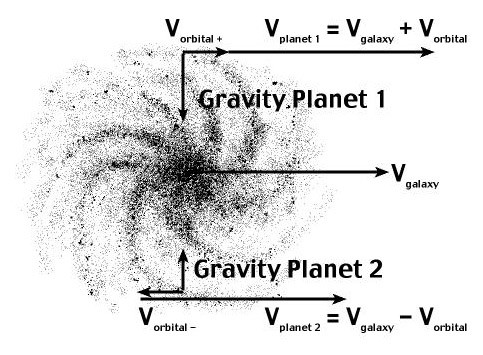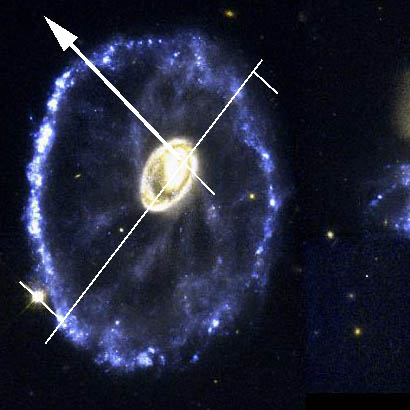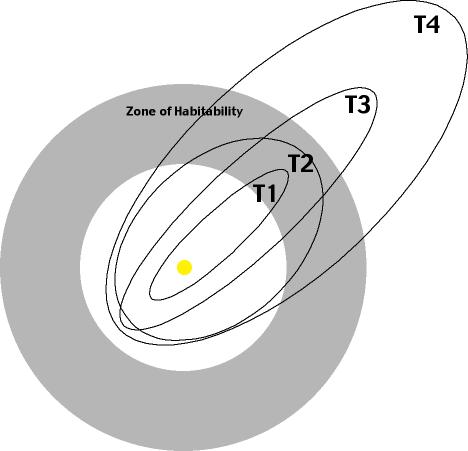The most important prediction that the Ball-of-Light Particle Model makes that would affect geology is that gravity is not a constant. It can vary. Specifically, if an object is accelerated, in any direction, it will induce a higher gravitational field.
It is observed that galaxies are receding from each other. It is debatable whether this recession is simply objects moving away from each other, or this recession is space itself is expanding. I prefer to think of this recession is due to objects simply moving away from each other. For this argument though, it doesn't matter which side you take.
It is an observational fact that spiral galaxies spin. It is an observational fact our Milky Way Galaxy is a spiral galaxy.
If our galaxy is moving through space, relative to the center of the Big Bang -- or relative to any expanding sphere of light -- and if our galaxy is spinning, then half of our galaxy is moving faster -- because its motion combines with the galactic motion -- and half of our galaxy is moving slower -- because its motion subtracts from the galactic motion. This can be seen in the graphic below. (I call this the helicopter blade effect.) The galactic velocity is "V galaxy". Planet 1 is moving, at the top of the graphic, to the right in the same direction as the galaxy is moving. Its orbital velocity combines with the galaxy's velocity. Planet 2 is moving to the left. Its velocity subtracts from the galaxy's velocity. (Again, the reference frame is the Big Bang or any expanding sphere of light.) Because the overall velocity of the stars and planets in this galaxy -- in the top portion of the graphic -- is greater than the average velocity of the galaxy, the stars and planets in this region experience a greater than average gravitational field. Planets and stars in the bottom portion of the galaxy in this graphic would experiece less than average gravitational fields.

Thus, over hundreds of thousands of years, stars and planets will experience larger and smaller gravitational fields -- depending on where they are in the galactic orbit. Observationally the galaxy will be tighter on the high gravitation side, and looser on the low gravitation side. Below are two examples: the Cartwheel Galaxy and NGC 4414.


Note the center of each galaxy is not in the center of the ellipse. It is an observational fact. Almost every spiral galaxy I have looked at appears to have some shift of the core off center.
If you doubt this simple geometric relationship, then take any round object and tip it so it appears elliptical. No matter what angle you view the ellipse from, the center of the circle will remain at the center of the ellipse. Geometrically, viewing a circle from an oblique angle does not move the center. So why does almost every elliptical galaxy have its core shifted from the geometrical center of the ellipse? Because the gravitational field of the galaxy varies around the orbit.
If the objects -- superclusters, clusters of galaxies, galaxies, stars, planets, etc. -- are slowing down as they speed away from the center of the Big Bang, then what does this imply for a galaxy's gravitational field? (I do not believe reports that the objects in the universe are speeding up. They are based on analysis that does not understand time, gravity, or even the primary source of a star's energy.) If a galaxy's motion is slowing with respect to the center of the universe, the Big Bang, or any expanding sphere of light, then, over time, the gravitational field in the galaxy will decline. One result is the galaxy will gradually expand to a larger diameter. More importantly for us, over time, a star or a planet, in the greater galactic orbit, will experience increases and decreases in the gravitational field that will gradually weaken over time.

If gravity varies for an example star and its planet as they orbit around a galaxy, then the elliptical orbit of the planet will vary significantly over a long period time. (About 100,000,000 years for earth.) This will have major implications for interpreting data on how earth has evolved, for interpreting mass extinctions, for understanding the orbit of the moon, and for understanding ice ages and many other things such as long-term weather data.
In the graphic below is a planet with an elliptical orbit. Early in the history of the planet, during epoch 1 -- T1 -- the orbit is tight and highly elliptical. This will result in very high tectonic activity. Huge mountains could be formed during this point of the planet's history. Later gravity drops off. During this epoch of lower gravity -- T2 -- the planet's orbit will expand, slow and become more circular. This might be a time where larger animals -- such as dinosaurs -- can develop on the planet. Later, gravity increases during epoch T3. The orbit is still overall larger than during epoch T1, however it once again becomes more elliptical. During this period -- epoch T3 -- tectonic activity will increase because of the greater gravitational fields. There will be greater variation of the forces on the crust of the planet from having a more elliptical orbit. Impacts from space objects would also increase. The increase in gravity would dislodge objects from their orbits -- such as within our Kuiper Belt. This is very interesting to me. Data on mass extinctions for earth seems to indicate that there was an increase of impacts from space objects during the mass extinctions, as well as coinciding with increases in tectonic activity. If gravity increases on the planet, then very large animals would fair worse than smaller animals or sea creatures, as occurred during the dinosaurs' extinction.
Later, gravity will drop off, and once again the orbit of the planet would become more circular.

What impact would the varying gravitational field have on the star? According to my theories on star formation, a star experiencing an increasing gravitational field would be more stable. It would burn cooler. The planets surrounding it would more likely experience Ice Ages. As the gravity decreases, the star would become less stable and give off more energy. Planets surrounding the star would experience warming.
However, at peak gravitational periods, the elliptical orbits of the planets would make the star less stable. There would be more sunspots, solar activity, and energy from the star. During low gravitational periods, the more circular orbits of planets would lend to a more stable and quite star. These to factors are not in phase with each other.

I am only making a rough approximation, but the physics leads me to believe that the effects of the two combine to make things worse at or just before the gravitational field peaks in the galactic orbit.
The implications for this prediction -- that gravity can vary -- are dramatic for some areas of science -- especially for any area of science that tries to look at history over a long period of time.
(See also, Gravitational Induction of an Electromagnetic Wave on a Ball-of-Light, and The Galaxy's 200,000,000 year orbital cycle)